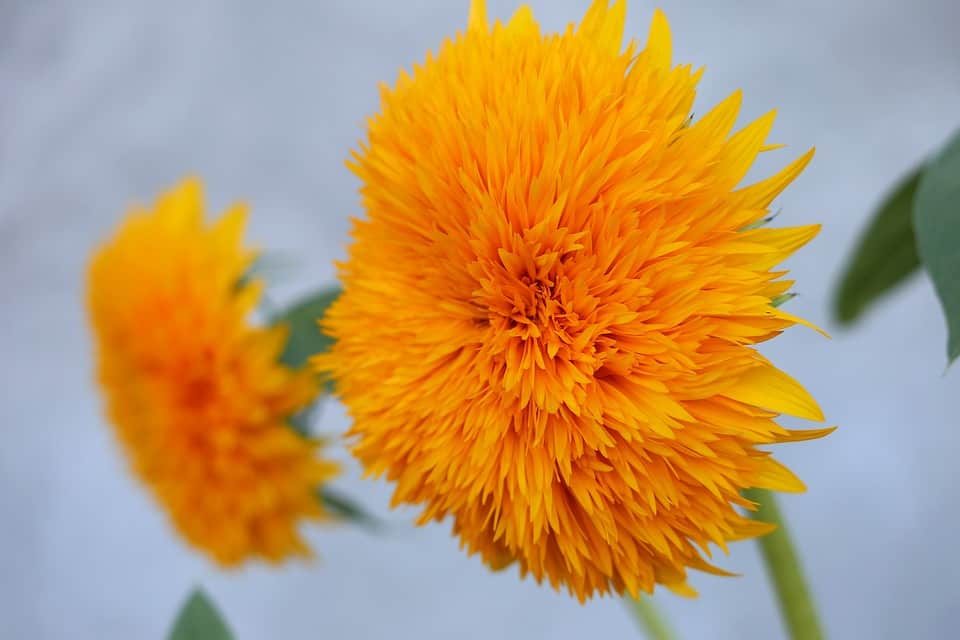Sunflowers come in different sizes and colors, but a lot of people first get interested in growing sunflowers to have a massive flower towering over them. If you’ve planted sunflowers that started flower before they were barely taller than you, there are several possible reasons, including damaged roots during transplanting, an early cold snap, or a nutrient deficiency.
Below are the common reasons why your sunflowers may be short, including tips to fix them for next season so you can grow sunflowers everyone in your neighborhood will be seeing when they drive down the street.
On this page:
Why Your Sunflowers Are Short
1. Late transplanting
Sunflowers grow best when direct sown, however you can start them indoors and transplant outside. The problem is that sunflowers have a deep taproot, and if you let your sunflowers get too mature in their starter pots, the roots won’t be able to support a large plant later in the season, leading to shorter plants. Furthermore, sunflower roots are quite sensitive, similar to cucurbits like cucumbers and squash, and should be transplanted very carefully so as not to damage them. The sunflowers will recover, but may end up shorter than their potential.
When sowing sunflowers indoors, transplant out no later than when the first true leaves appear, and be careful not to damage the roots.
While this is a common reason for shorter sunflowers, some gardeners purposely let their sunflower seedlings get rootbound before transplanting in order to keep their sunflowers shorter. This can mean a naturally 6-foot tall ornamental sunflower can be stunted to a more manageable 3 to 4 feet.
2. Cold weather damage
Sunflowers are frost tender and don’t like very cold temperatures. If your sunflower seedlings are hit with a sudden cold snap or narrowly survive a freak frost, even if they appear healthy, they could end up being stunted for the season.
To prevent this, sow or transplant sunflowers well after the threat of frost has passed and soil temperatures are at least 50°F (10°C).

3. Crowded sunflowers
Sunflowers have a root system proportional to their size above the ground, so large sunflowers have wide, deep roots. Some super large varieties like the Russian Mammoth or Titan can have roots growing several feet deep. So, the larger your sunflower, the more space they should get, or else they will have to compete with their neighbors and overall grow smaller than their potential.
If you’re planting very tall, large-headed sunflower varieties, ideally you should plant them 3 feet (1 meter) apart.
4. Nutrient deficiency (Nitrogen)
Nitrogen is one of the most important macronutrients for plants, along with phosphorus and potassium. Nitrogen is important for a lot of processes and protein synthesis which power growth. In the garden, more nitrogen will noticeably boost leaf and stem growth. Next time you see a yellow patch of grass where a dog did his business, look at the grass immediately around that patch; you will usually see a thicker, fuller, and faster-growing ring of grass around the yellow patch. This is the power of nitrogen – too much will kill a plant, but just the right amount will massively improve its growth.
Nitrogen is especially important for sunflowers, as this is the key nutrient that will give your sunflowers bigger leaves and taller, thicker stems. Nitrogen is also beneficial for sunflower seed development, as more leaves will allow your sunflowers to collect more energy and synthesize important molecules that are transported into the seed during kernel growth (called seed filling).
In the early stages of sunflower growth, before the sunflower starts budding and flowering, use either a balanced or higher nitrogen fertilizer (high N in the listed NPK numbers), either feeding with a continuous release fertilizer reapplied as per the instructions (usually 1-2 months) or feeding with an instant release liquid fertilizer every 7 to 14 days.

5. You’re growing a short variety
It’s entirely possible that you’re growing a shorter sunflower variety. A lot of sunflowers reach maturity at 3 to 4 feet, and there are dwarf varieties that naturally never grow larger than 1-3 feet. If you grew a tall sunflower variety the previous year and saved your seeds, and this year your sunflowers are short, another possibility is cross-pollination with a shorter variety grown nearby.
Dwarf and Super Tall Sunflower Varieties
Dwarf Sunflowers
- Dwarf Sunspot (2-3 feet)
- Teddy Bear (2-3 feet)
- Firecracker (2-3 feet)
- Bert (14-16 inches)
- Junior (2 feet)
- Big Smile (10-15 inches)
- Elf (16 inches)
Super Tall Sunflowers
- Skyscraper (12-14 feet)
- Russian Mammoth (9-12 feet)
- Titan (10-12 feet)
- Mammoth Grey Striped (10 feet)
- Mongolian Giant (12-14 feet)
How Do You Make Sunflowers Grow Tall? (Checklist)
Given what we know about what causes sunflowers to stay short, here’s the checklist of things you should do to let your sunflowers reach their genetic potential.
-
- Direct sow your sunflowers if possible. Direct sowing ensures your sunflowers can grow strong, deep roots to support tall plants.
- Sow well after the threat of frost or cold spells can damage your sunflower seedlings. As a rule of thumb, sow your sunflowers when the soil is at least 50°F (10°C).
- Do not plant your sunflowers too closely. To maximize sunflower size, plant tall, large-seeded varieties 3 feet (1 meter) apart. However, you can sometimes get away with planting closer.
- Ensure your sunflowers have adequate nutrients, especially nitrogen. Applying a fertilizer with a balanced NPK or one with a higher N number in the vegetative growth phase of your sunflower plants will boost stem and leaf growth.
- Always double check what variety you’re planting, and plant tall sunflower varieties. Short or dwarf sunflower varieties, or tall varieties cross-pollinated with short ones, won’t grow as tall, even if given enough space and nutrients.
